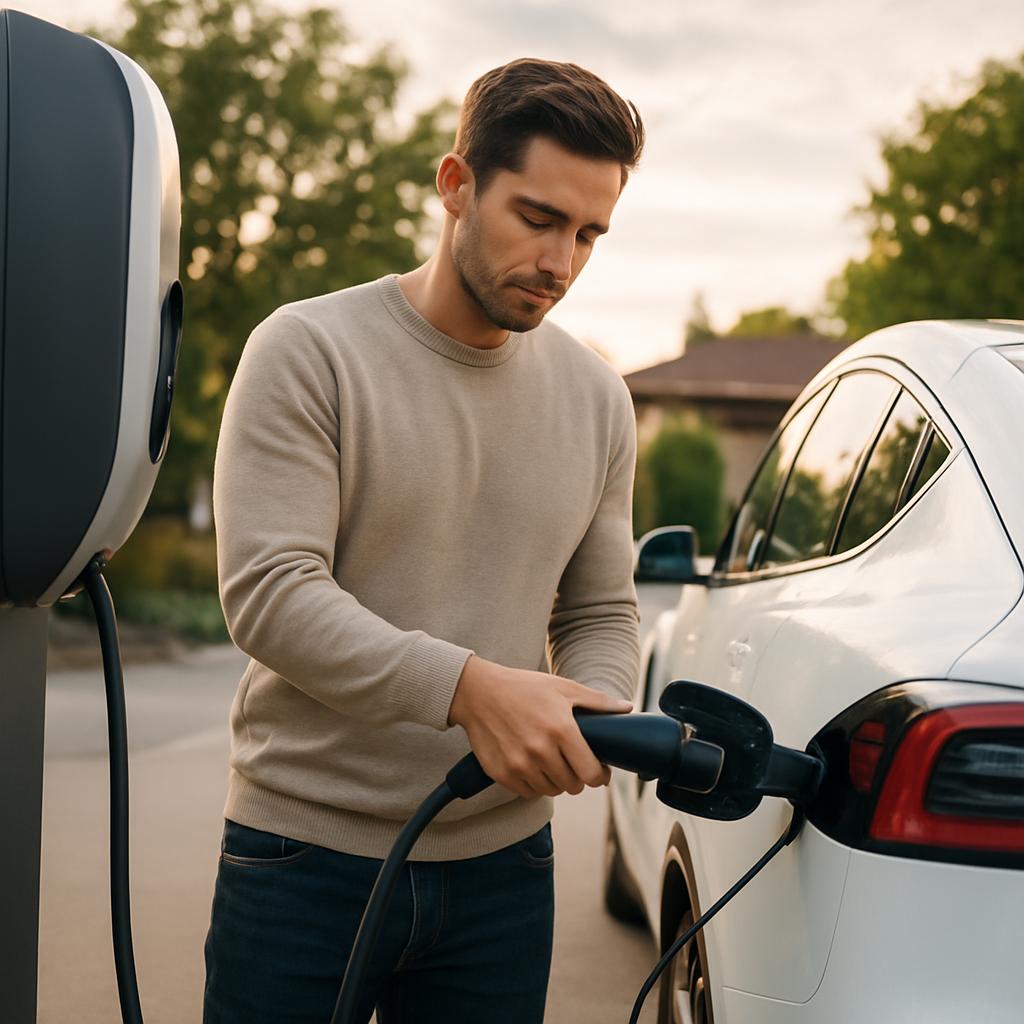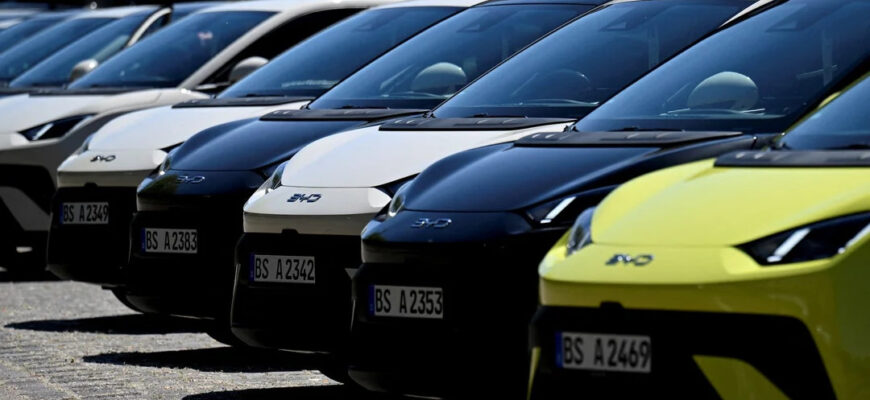It’s a chilly morning in June 2025, and I’m sipping coffee in a small café in Warsaw, scrolling through the latest news on my phone. One headline catches my eye: Chinese automaker BYD has just surpassed Tesla in electric vehicle (EV) sales in Europe for the first time, kicking the American giant out of the top 10 EV brands. The numbers are striking—BYD sold 7,231 cars in April, a 169% jump from last year, while Tesla moved 7,165 units, down 49%. This shift, reported by JATO Dynamics, marks a turning point for the European EV market. As journalists at The Mors, we’ve dug into what this means for buyers, the market, and the future of electric cars in Europe. Let’s break it down. Clicking here
- A New Leader in Europe’s EV Market
- Top 10 EV Brands in Europe: Where Does BYD Stand?
- Why Is BYD Gaining Ground?
- What’s Behind Tesla’s Decline?
- How Does BYD Compare to Other Top Brands?
- What Does This Mean for European Buyers?
- The Bigger Picture: Chinese EVs in Europe
- What’s Next for BYD and Tesla?
- Tips for Choosing Your Next EV in Europe
- The Future of EVs in Europe
- Frequently Asked Questions (FAQ)
A New Leader in Europe’s EV Market
For years, Tesla has been the king of electric cars in Europe. Models like the Model 3 and Model Y became symbols of the EV revolution, dominating sales charts since the company entered the market in 2014. But April 2025 changed everything. BYD, a Chinese automaker that only started selling in Europe in late 2022, pulled ahead with 7,231 battery-electric vehicles (BEVs) registered, compared to Tesla’s 7,165. The gap is small—just 66 cars—but the implications are massive.
I remember driving a Tesla Model 3 in Berlin a couple of years ago. It felt like the future—sleek, fast, and packed with tech. But Tesla’s recent struggles are hard to ignore. Sales dropped 49% year-over-year in April, and the brand fell to 11th place among EV makers in Europe. Meanwhile, BYD’s growth is staggering, up 169% from last year. This isn’t just a fluke; it’s a sign of a shifting tide. Europe’s EV market is heating up, and Chinese brands are making their mark.

Top 10 EV Brands in Europe: Where Does BYD Stand?
Let’s look at the numbers. Here’s the top 10 list of EV brands in Europe for April 2025, based on new registrations:
- Volkswagen: 23,514
- BMW: 14,867
- Skoda: 13,598
- Renault: 10,328
- Kia: 9,101
- Mercedes: 8,739
- Volvo: 7,768
- Hyundai: 7,346
- BYD: 7,231
Volkswagen leads by a wide margin, thanks to popular models like the ID.3 and ID.4. Skoda’s Elroq, a compact SUV, topped the charts as the best-selling EV model in April with 8,000 units. But what stands out is BYD’s entry into the top 10, while Tesla slips to 11th. I’ve driven the Skoda Elroq myself—it’s practical, affordable, and perfect for European roads. But BYD’s rise is what’s turning heads.
Why Is BYD Gaining Ground?
BYD’s success isn’t just about numbers; it’s about strategy. First, their prices are hard to beat. The BYD Dolphin, their most affordable model in Europe, starts at €22,990 (around 2 million rubles). Compare that to the Tesla Model 3, which costs nearly double at €42,000. I spoke to a friend in Paris who recently bought a Dolphin. “It’s a no-brainer,” he said. “For the price, I get a solid range—up to 507 km—and it’s cheaper to maintain than my old gas car.”
Second, BYD offers variety. Unlike Tesla, which focuses solely on BEVs, BYD sells both pure electric cars and plug-in hybrids (PHEVs). In April, their total sales, including PHEVs, jumped 359%, reaching 12,525 units. This flexibility appeals to European buyers who might not be ready to go fully electric. I saw this firsthand in Germany, where a colleague opted for a BYD hybrid because charging stations near his village are still sparse.
Third, BYD is playing the long game. They’ve expanded their lineup with models like the Dolphin Surf (a rebranded Seagull) and are building a factory in Hungary to avoid EU tariffs on Chinese-made cars. These tariffs, introduced last year, hit BYD harder than Tesla, but the company adapted by diversifying its offerings. As Felipe Munoz from JATO Dynamics noted, “Europe is emerging as a central battleground between BYD and Tesla.” And BYD is clearly ready to fight.
What’s Behind Tesla’s Decline?
Tesla’s drop to 11th place isn’t just about BYD’s rise—it’s about their own challenges. Their sales fell 49% in April, and the Model Y, once a top seller, slipped to 9th place with 4,495 registrations, down 53%. The Model 3 didn’t even make the top 20. I’ve been following Tesla for years, and this decline feels personal. I loved the Model Y’s acceleration, but its high price and recent controversies are turning buyers away.
One big factor is Elon Musk’s political involvement. His support for Donald Trump and his role in the U.S. administration have sparked backlash in Europe. I saw protests in Berlin last year where people held signs saying, “No Musk, No Tesla.” This sentiment is hurting sales—Tesla’s registrations in Germany and the UK hit a two-year low in April. Add to that an aging lineup and production halts to retool factories for a redesigned Model Y, and Tesla is struggling to keep up.
How Does BYD Compare to Other Top Brands?
BYD’s 9th place in the top 10 is impressive, but they’re still far behind Volkswagen’s 23,514 sales. VW’s success comes from a strong lineup—models like the ID.7 saw a 640% sales jump in April. Skoda, another VW brand, is also thriving with the Elroq, while Renault’s new Renault 5 sold over 5,600 units, landing in 6th place. Kia’s EV3 and Hyundai’s models are also gaining traction, showing that Korean brands are serious players.
What sets BYD apart is their growth rate. A 169% increase in BEV sales is unmatched, and they’re already outselling established European brands like Fiat and Seat in markets like France and the UK. I visited a BYD dealership in Warsaw recently, and the buzz was palpable. Customers were drawn to the Dolphin’s price and sleek design, and the staff told me they’re seeing more interest every week.
What Does This Mean for European Buyers?
For anyone looking to buy an electric car in Europe, BYD’s rise is good news. More competition means better prices and options. The BYD Dolphin at €22,990 is a steal compared to the Tesla Model 3 or even the Renault 5, which starts around €25,000. I test-drove the Dolphin last month, and for the price, it’s hard to beat—decent range, modern tech, and a comfy interior.
But Tesla still has its strengths. Their Supercharger network is unmatched, and the Model Y’s performance is top-notch. If you’re set on a Tesla, you might wait for the redesigned Model Y later this year. I’ve charged at Tesla stations across Europe, and the convenience is a big draw. But with BYD expanding and new models like the Dolphin Surf hitting the market, buyers have more affordable choices than ever.
The Bigger Picture: Chinese EVs in Europe
BYD’s success is part of a larger trend. Chinese automakers are making waves in Europe, despite EU tariffs. Registrations of Chinese-made EVs rose 59% in April, reaching 15,300 units, while PHEVs from Chinese brands soared 546%, hitting 9,649 units. This growth is shaking up the market—Chinese brands now hold 10% of the PHEV segment. I saw this shift in Poland, where BYD and other Chinese EVs are becoming more common on the roads.
The EU tariffs, meant to protect local manufacturers, haven’t slowed Chinese brands down. Instead, companies like BYD are building factories in Hungary and Turkey to bypass the tariffs. This localization strategy, combined with competitive pricing, is helping them gain ground. As Liz Lee from Counterpoint Research told CNBC, “Europe is expected to experience higher electric vehicle market growth this year than China.” And BYD is leading the charge.
What’s Next for BYD and Tesla?
BYD isn’t stopping here. They’re on track to sell 186,000 vehicles in Europe in 2025, according to S&P Global Mobility, up from 83,000 last year. By 2029, that number could hit 400,000. Their new factory in Hungary will boost production, and models like the Dolphin Surf, priced under €20,000, are set to attract even more buyers. I’m excited to see how BYD’s luxury Denza brand performs—it launched in Europe last month and could challenge premium brands like BMW and Mercedes.
Tesla, meanwhile, needs to regroup. They’re planning to expand their factory in Germany, and the redesigned Model Y could help them regain ground. But with sales down 30% in the first quarter of 2025 and Musk’s controversies dragging on, they face an uphill battle. I still believe in Tesla’s tech—their Full Self-Driving system is impressive—but they need to focus on what made them great: innovation and customer trust.
Tips for Choosing Your Next EV in Europe
If you’re in the market for an electric car, here’s what to consider:
- Budget: If you’re looking for value, BYD’s Dolphin at €22,990 is a strong pick. For a premium experience, BMW or Mercedes might be worth the splurge.
- Range and Charging: Tesla’s Supercharger network is a big plus, but BYD’s Dolphin offers up to 507 km of range, which is plenty for most drivers.
- Purpose: Need a family SUV? Skoda’s Elroq or Kia’s EV3 are great options. For city driving, the Renault 5 or BYD Dolphin are more practical.
- Future Trends: Keep an eye on BYD’s new models and Tesla’s updates. The market is moving fast, and new options are coming.
I’ve been driving EVs for years, and my advice is simple: test-drive a few models before deciding. Every car has its own feel, and what works for me might not work for you.
The Future of EVs in Europe
The European EV market is at a crossroads. Battery-electric vehicles now hold a 17% market share, up from 13.4% last year, and PHEVs are at 9%. Together, electrified vehicles made up 26% of new car registrations in April—a record high. But as JATO Dynamics points out, EV sales need to grow faster to offset the decline in gas and diesel cars. I’ve seen this shift myself—charging stations are popping up everywhere, and more friends are switching to electric.
BYD’s rise and Tesla’s stumble show that competition is fiercer than ever. European brands like Volkswagen and Renault are holding strong, but Chinese automakers are here to stay. For buyers, that means more choices and better prices. For the planet, it means a faster shift to cleaner transport. At The Mors, we’re committed to keeping you updated on this evolving market.
Frequently Asked Questions (FAQ)
Why did BYD overtake Tesla in Europe?
BYD’s affordable prices, like the Dolphin at €22,990, and a diverse lineup of electric and hybrid models drove a 169% sales increase in April. Tesla’s sales fell 49% due to high prices and backlash over Elon Musk’s political involvement.
What is the top-selling EV brand in Europe?
Volkswagen led with 23,514 sales in April 2025, followed by BMW and Skoda. BYD ranked 9th with 7,231 sales, just ahead of Tesla’s 7,165.
How much does the cheapest BYD cost in Europe?
The BYD Dolphin starts at €22,990 (about 2 million rubles), making it one of the most affordable EVs in Europe.
Is Tesla still a good choice for European buyers?
Tesla offers great tech and charging infrastructure, but their higher prices and recent sales drop make competitors like BYD more appealing for budget-conscious buyers.
Want to stay updated on the latest EV trends and market shifts? Visit The Mors – Breaking News for more insights, reviews, and tips on electric cars and sustainable living. Check out our other articles to find the best EV for your needs!









